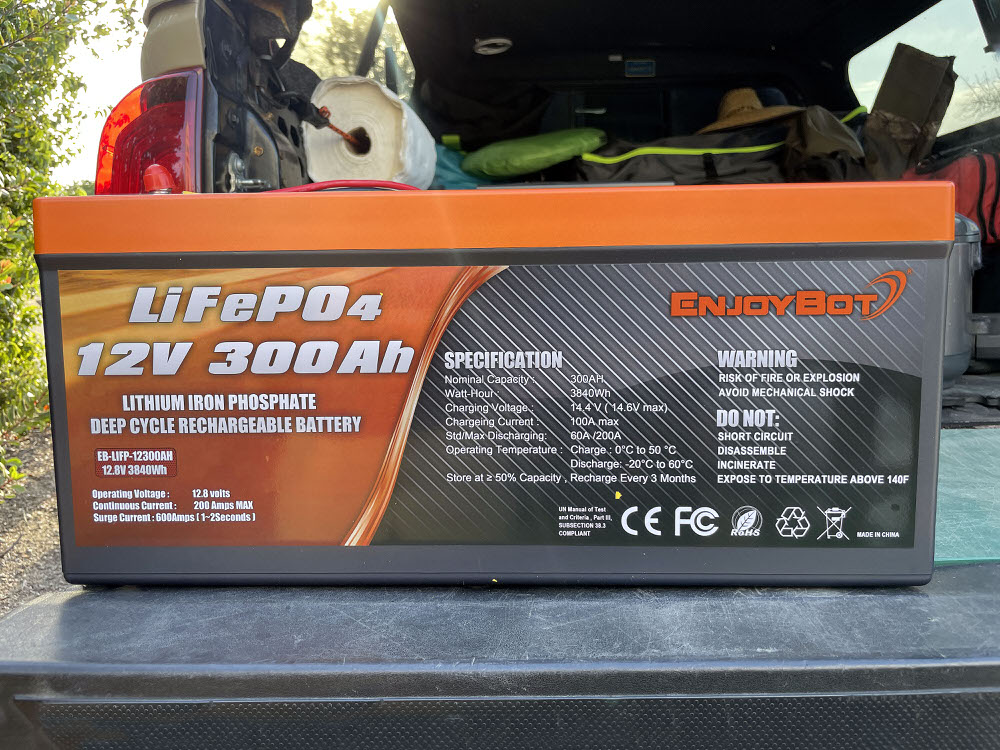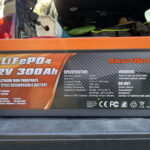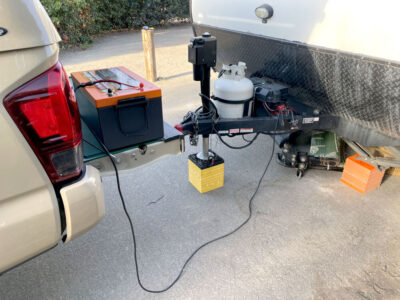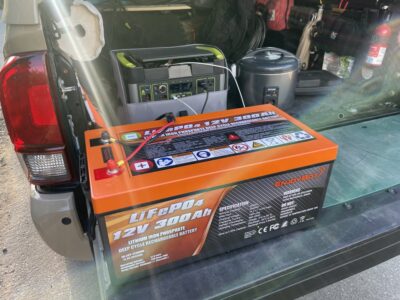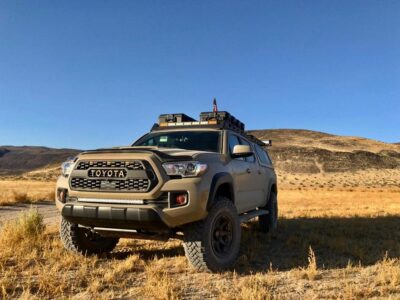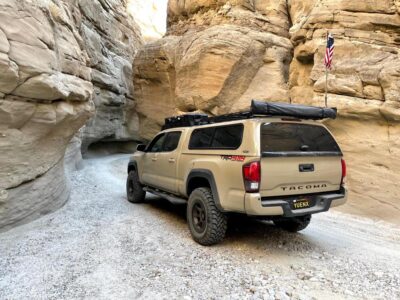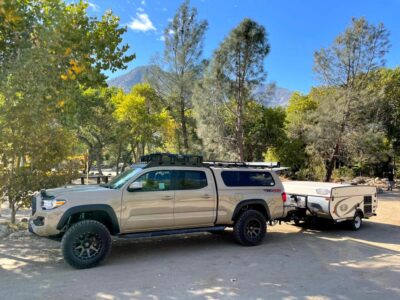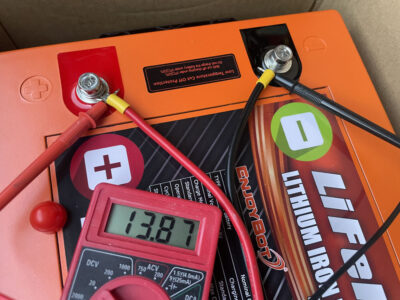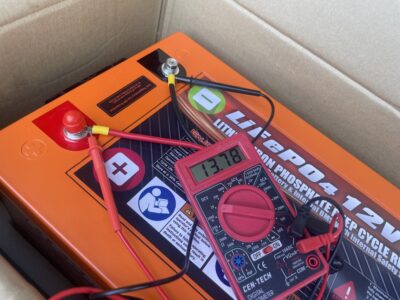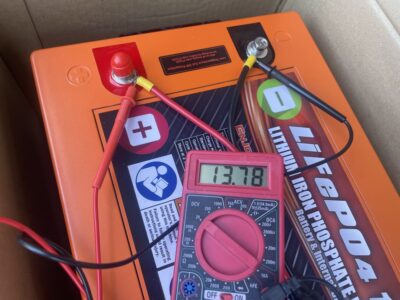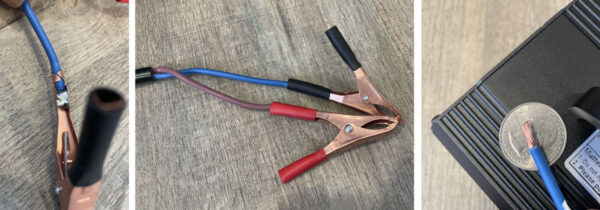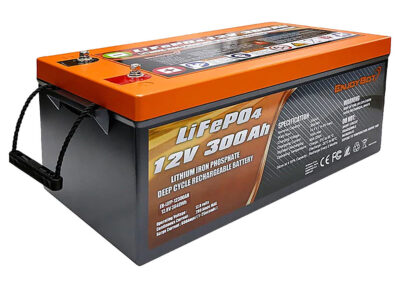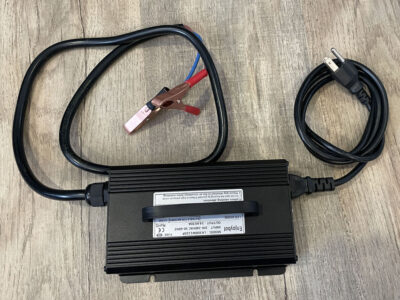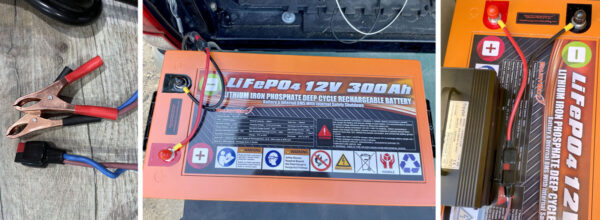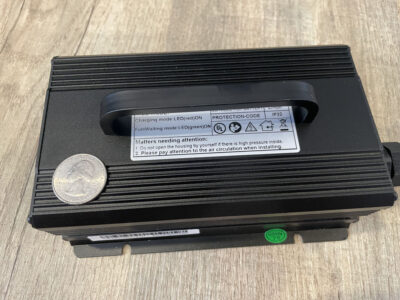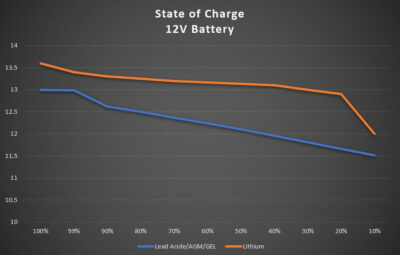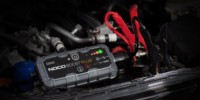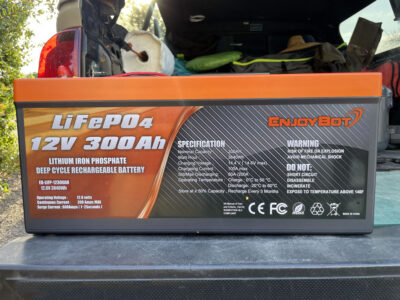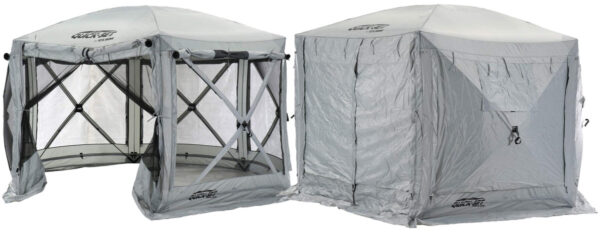EnjoyBot 300Ah 12V LiFePO4 Battery, 200A BMS (971-HE-12V-300AH) and 4.6V-20A Charger
Contents
Travel Trailer Power
When we purchased our first travel trailer a little over a year ago, we immediately knew that the single 65Ah deep cycle battery that it came with was not going to cut it. We prefer boondocking over staying at developed camp sites. This means we need the trailer to be self-sustaining for at least a week or more. As soon as we brought the trailer home, we immediately upgraded the battery to two (2) Group 31 AGM batteries. This more than tripled our power capacity but at the same time added nearly 75 lbs to our trailer’s tongue weight. Tongue weight is the amount the trailer puts on the tow hitch which is then transferred to the vehicle’s suspension. The additional weight was immediately apparent because there was substantially more sag on the vehicle’s rear suspension, reducing the car’s performance and posing a potential safety risk.
After just a few trips with the new battery setup, we knew that 110Ah was simply not enough, and adding more AGM batteries was not an option due to the location of the batteries and how they impact the trailer’s tongue weight. The batteries were mounted near the trailer’s tongue: any weight added there would transfer to the vehicle. After many hours of research, the solution we chose to make the switch to as the latest and greatest in battery technology: Lithium Iron Phosphate (LiFePO4 / LFP). We picked the EnjoyBot 300Ah 12V LiFePO4 (12V-300Ah-PLUS / 971-HE-12V-300AH) battery.
What Will Be Covered Here
In this review, we will go over:
- Lithium Iron Phosphate (LiFePO4) compared to traditional, automotive (AGM) batteries
- Pros and Cons of the EnjoyBot 12V 300Ah LiFePO4 battery
- Lithium charging
- EnjoyBot 14.6V-20A LiFePO4 Charger
- Power basics, such as Watts, Watt-hours, Continuous vs Peak rating, and more
Why LiFePO4 over AGM?
The primary reason we decided to make the jump to LiFePO4 after just spending hundreds of dollars on AGM batteries (what many cars use) is simply for the weight saving. Two AGM batteries weighed a combined 130lbs (19.20 oz per amp hour of power), whereas the EnjoyBot is just 70.59lb (3.76 oz per amp hour). This equates the LiFePO4 to 80% less weight per usable ampere hour than AGM.
Weight-To-Power Calculation:
- LiFePO4: Weight / (Capacity in Amp hour x 0.85) = Weight per usable amp hour
- AGM/Lead Acid/Deep Cycle: Weight / (Capacity in Amp hour x 0.50) = Weight per usable amp hour
My Use Case
As previously mentioned, we are using the EnjoyBot 300Ah 12V battery to power our 16-foot travel trailer that holds a large 12v refrigerator, lights, fans, water pump, and anything that may need power — except for the air conditioner that requires AC shore power. The EnjoyBot 300Ah can comfortably power all of those for about eight (8) days without any form of charging.
We currently do not have the battery mounted onto the trailer so it can be flexibly used anywhere we choose. For now, it serves as a standalone power pack that can be tied into our trailer’s electrical system by simply connecting an extension cable and flipping a three-way power switch. This allows the battery to be easily moved and used for other applications, such as on a boat, on our truck while camping on top of it, or even as a power tank to charge our Goal Zero Yeti 1500x, a power station that came highly recommended by one of our editors. In addition to more flexibility, this transfers the weight of the battery from the front of the trailer (where it impacts the tongue weight the most) to a more efficient location like inside the tow vehicle or inside the trailer near its axle.
Check it out!
Devos LightRanger is one of our favorite, full-coverage lights for camping, boondocking/overlanding, sports, and grilling with its built-in battery and 9′ telescoping pole.
What’s Good? What’s Bad?
Here is what we liked and disliked about the EnjoyBot 300Ah 12V LiFePO4 battery.
Pros
In addition to increasing the amount of available power capacity, the EnjoyBot has NOT negatively impacted our overall tow weight. Furthermore, it “enjoys” (pardon the pun) many advantages over AGM and other battery technologies.
- Charging Efficiency
- Maximum continuous charging current of 100A (about 3x faster than an equivalent AGM)
- Enables us to quickly charge the batteries at a moment’s notice without having to sit there and wait for it to fill
- Flat Voltage Discharge
- Some appliances’ performance, like a refrigerator, can be impacted if the voltage fluctuates too widely. LiFePO4 maintains a stable voltage discharge through most of its discharge cycle, thereby increasing the appliance’s performance and longevity
- Life Cycle
- The EnjoyBot, like other LiFePO4 batteries, has a 5,000-charge lifecycle @ 80% DOD. That means that after 5,000 cycles, the battery will still have 80% of its originally rated capacity
- In the case of this EnjoyBot 300Ah (971-HE-12V-300AH), it will still supply 3,000Wh of power after 5,000 charge and discharge cycles. For perspective, if the battery is cycled once a week every week, it will theoretically reach 5,000 cycles in 96 years, longer than the average lifespan of its users
- The EnjoyBot, like other LiFePO4 batteries, has a 5,000-charge lifecycle @ 80% DOD. That means that after 5,000 cycles, the battery will still have 80% of its originally rated capacity
LiFePO4 batteries have a high charge lifecycle of 5,000 after which they keep about 80% of their original capacity.
- Slower Self-Discharge
- It is normal for batteries of any chemistry to lose power over time (self-discharge). Batteries in long-term storage should be charged periodically to maintain its overall health. Allowing it to discharge too low can cause unrepairable damage to the battery
- LiFePO4 has a slower self-discharge rate — about half as fast as an AGM battery. This results in less needed maintenance
- Direct Replacement to Sealed Lead-Acid (SLS) and AGM Batteries
- EnjoyBot 300Ah uses standard, automotive battery housings, and as a result, makes it a direct replacement for most applications, like upgrading an RV’s house battery (what supplies 12V to the vehicle)
- Installation on an RV, as such, can be as simple as replacing the starter battery found in most vehicles
Cons
The drawbacks and shortcomings of the EnjoyBot 300Ah are not entirely specific to this particular product, but LiFePO4 in general.
- Operating Temperature Range
- LiFePO4 has a safe operating temperature of -4F – 140F. That is not substantially less than other battery types. However, Lithium can incur irreparable damage to the battery when used outside that range. Traditional batteries, on the other hand, only experience reduced performance, a higher self-discharge rate, and reduced longevity
- EnjoyBot has a built-in, high-temperature charge protection that will shut the battery off when the high limit is reached, keeping the battery safe from imminent damage
- No low-temperature protection — Exercise caution when used in temperatures colder than -4F or get the Low-Temp model (971-HE-12V-300AH-lowtemp)
This battery has a built-in, high-temperature charge protection, but does not have a low-temperature safety shutoff. EnjoyBot has released a model with both temperature shutoffs built in.
- Charging Voltage
- LiFePO4, similar to AGM batteries, requires a charging voltage of about 14.2V – 14.6V. That requirement is higher than lead-acid or deep cycle batteries
- Many RVs (Recreational Vehicles) like ours are not equipped with a converter that will fully charge a LiFePO4 battery. I will detail more on charging later in this review
- Potentially Costly Upgrades Required
- Depending on your application, additional, costly upgrades may be required to take full advantage of the EnjoyBot LiFePO4 battery
- DC-to-DC charger
- Alternator upgrade to accommodate the higher voltage demand
- Installation of a proper charge controller
- Depending on your application, additional, costly upgrades may be required to take full advantage of the EnjoyBot LiFePO4 battery
Cost Analysis
Most people think that Lithium-Ion batteries cost many times more than a traditional, lead-acid, deep cycle marine, or AGM battery. That is absolutely not the case.
For comparison, the two AGM batteries I had previously purchased cost $275 each (about $5 per usable Amp hour of power: $275 / (110Ah x 50%)). The EnjoyBot LiFePO4 costs $4.24 per usable amp hour ($1,079.99 / (300Ah x 85%), making it 15% cheaper than the AGM. Considering the other added values such as weight, charge efficiency, life span, and voltage stability, lithium is the clear winner for overall value.
EnjoyBot Battery Specifications
- Nominal Voltage: 12V
- Capacity: 300Ah or 3840Wh
- Life Cycle: 5,000 @ 80% DOD
- Weight: 71.21 lbs (32.3kg)
- Dimensions: 20.55″ L x 9.45″ W x 8.58″ H (52.2 cm x 24cm x 21.8cm)
- Waterproof Rating: IP65 (protected against dust and low-pressure water jets). Battery cannot be submerged in water
- Recommended Charge Voltage: 14.2V – 14.6V
- Max Depth of Discharge: 100%. Frequently discharging to 100% depth of discharge will reduce the battery’s lifetime
- Max Load/Inverter Power: 3,840W. Although the EnjoyBot 300Ah has a max load of 3,840W, discharging it at a high rate will reduce its lifespan. Avoid high-wattage electronics (like a large microwave) as much as possible
- Operating Temperature: Charge (32F – 120F, 0C – 50C), Discharge (-4F – 140F, -20C – 60C), Storage (14F – 122F, -10C – 50C)
- EnjoyBot 300Ah does not have low-temperature protection. Consider getting the Low-Temp model (971-HE-12V-300AH-lowtemp) when operating in colder climates
Charging and Chargers
The EnjoyBot 300Ah battery has a standard, charging current of 60A and a maximum, continuous charge current of 100A @ 14.2V – 14.6v. Because of the high charging current, we purchased the larger EnjoyBot 14.6V-20A LiFePO4 Charger (Amazon / EnjoyBot). It has a no-frills design but offers some notable features.
- Made of lightweight aluminum — weight savings are important to us
- Alligator clips for universally connecting to just about any battery
- I opted to convert the clip to an Anderson Power Pole (APP) connector (with a Ratchet Crimping Tool) because it is the secure connection of choice for all of my equipment. Solar panels often use APP plugs as well
- APP minimizes the risk of crossing wires or incorrectly connecting to a charger. Alligator clips have a tendency of potentially getting crossed and short-circuiting the battery and/or any connected electronics
- I opted to convert the clip to an Anderson Power Pole (APP) connector (with a Ratchet Crimping Tool) because it is the secure connection of choice for all of my equipment. Solar panels often use APP plugs as well
- Cables are a thick, 10-gauge, pure copper, making them suitable for a 20A charger
- Cable from charger to battery: 36″. Wall to charger: 60″
- Quiet fan
- LED charge indicator: Red = charging. Green = fully charged
I did not like the charger’s carry handle as it protrudes and makes it more difficult to store. Storage space can be a premium with RVs and campervans.
EnjoyBot Charger Specifications
- Constant Voltage: 14.6V (LiFePO4)
- Lithium requires a higher charge voltage than other types of batteries, and so it is important to use a charger designed for lithium
- Constant Current: 20A
- Charging current of the charger: A higher charge current means faster charging time
- Max Output Power: 360W
- Output voltage: 14.6V+/-0.2Vdc
RV and Tow Vehicle Charging Systems
In most cases, when used in a recreational vehicle like a travel trailer, additional, costly upgrades are recommended to take full advantage of the EnjoyBot 300Ah, such as a more advanced converter designed to charge lithium batteries. Most build-grade converters on RVs are designed for lead-acid or deep cycle batteries. When charging a lithium battery, those converters can only charge up to about 80% of its capacity. Because we were already considering upgrading to a different travel trailer, we were hesitant to make this upgrade as it costs hundreds of dollars. So, for the interim, our plan has been to fully charge the EnjoyBot at home using the 20A AC charger before each trip. This will allow us to take full advantage of the battery’s capacity without investing more on a new converter. In addition to the converter, the RV’s or tow vehicle’s alternator should be upgraded to support the higher voltage and current draw of a LiFePO4 battery. With the higher demand comes higher wear-and-tear on a vehicle’s alternator, reducing its lifespan and potentially contributing to premature failure.
State-Of-Charge
Most battery monitors installed in RVs read the battery’s voltage and display its current state-of-charge based on the detected voltage. Different battery chemistries have different voltages at certain state-of-charges. So, it is important to note when upgrading to LiFePO4, that the state-of-charge readout could be inaccurate, if your current battery monitor is not programmed for or is incapable of reading lithium. If your current battery monitor is not designed to monitor lithium batteries, you may consider upgrading to one that does. Victron (BMV-712) and Renogy (500A) both make great lithium-compatible battery monitors.
Tips
- Most LiFePO4 batteries are not designed to be used as a starter battery. Using one as such can damage it and void the manufacturer’s warranty
- Avoid installing a LiFePO4 in an engine bay of your vehicle. The excessive heat will damage the battery
- Always test your devices with the power source before you depend on it on the go
- To prevent rust and oxidization on the terminals, apply a light coat of dielectric grease on the terminal lugs and any cables that make contact with the terminal
- To minimize fire damage to your belongings or loved ones, store the battery in the garage and not inside the house. Best storage is a dry, cool place, however
The battery’s lifetime can be extended by keeping its charge level between 20% – 80% of capacity.
- To extend the battery’s life, use partial discharge and recharge cycles
- When possible, recharge once it lowers to 20-30% of capacity, and stop at 80%. This will help increase the battery’s lifetime
- You should fully charge the battery every 3-6 months while it sits in storage
- Or, keep it plugged in when not in use and discharge it to 50% every 3-4 months
- NOT using the battery for a very long time can actually hurt its lifetime
- Avoid using high wattage devices. They can reduce the battery’s lifetime
- With the right BMS, quality batteries, and other factors, the battery can be stored in the car while camping during a hot, California summer
- Keep the battery out of direct sunlight. I usually store it on the floor of the car and crack open the windows a tiny bit
- Do not USE in the car if temperatures fall below or exceed the battery’s rated, operating temperature
Jump Start Car?
A battery like this one cannot be used to jump start a car. Instead, I suggest getting a small, portable one specifically made for that, such as one of our favorites: NOCO Genius Boost Car Jump Starter (Lithium Battery).
Calculations – Size & Time
What size battery should you get? How long will it power your fridge for? How long will it take to recharge? The below calculations can help answer those questions and are rough ESTIMATES as conditions, battery quality, and age can vary.
Time to Charge Battery
- Calc: Hours to charge battery = Battery capacity (Wh) / Input Wattage
- Note: As battery approaches 75% full, the input charge for many chargers will increasingly be slowed down to prevent overcharging
- 96W AC Wall charger with an empty, 537Wh battery: 5.6 hrs [537 Wh / 96W]
Charge Time with Solar
- Calc: Hours to charge battery = Battery capacity (Wh) / (Panel Wattage x [0.5 or 0.75])
- In a perfect lab environment, solar panels charge at the listed wattage
- Expect to only receive 50-75% on a good, sunny day (ie. 75W – 113W for a 150W panel), depending on panel’s age, component quality, and weather
- 100W solar panel and an empty, 537Wh battery: as fast as 6.1 hours [537Wh / (100W x 0.75)]
- Tips
- Keep charging even when overcast as the panels will STILL collect energy
- Underproduction: If a 100W panel is not making enough (ie. only 50W) due to bad conditions, adding an extra one can generate a higher, combined output (ie. 50W + 50W from the two panels = 100W total)
- Overproduction: If the panels make more (ie. 200W) than the maximum the power station charge port can take, only the max the power station can take will go through
Watts Used/Produced
- Calc: Watts used or produced by device = Voltage x Amperage
- Vacuum with 120V @ 9.5A uses 1,140W
- Solar panel with 12V @ 10A can produce up to 120W
Ideal Battery Size
- Calc: Battery capacity (Wh) = Watts used by device x Hours needed for / 0.85
- 10-15% of power is lost during power conversion
- 45W car fridge needed for 8 hours: Minimum 424Wh power station (45W x 8 / 0.85)
How much energy a battery can store is measured in Wh (Watt-hours), and how much power is used or produced in W (Watts).
Time Before Battery is Empty
- Calc: Hours available for device = Battery capacity (Wh) x 0.85 / Watts used by device
- 10-15% of power is lost during power conversion
- 60W laptop with 505Wh battery: Up to 7.2 hours (505Wh x 0.85 / 60W)
Time to Charge Device
- Calc: Hours to charge device = Device’s battery capacity (Wh) / Input Wattage
- 60W laptop with 200Wh battery: Up to 3.4 hrs (200 Wh / 60W)
Final Thoughts
The EnjoyBot 12V-300AH LiFePO4 features some of the latest and greatest in battery technology. Its 3,840 Watt-hours of energy is a huge upgrade from our old AGM batteries and provides enough power to boondock off-the-grid for over a week — or even indefinitely when paired with solar panels. With the addition of an inverter, it can double as a power station and provide thousands of Watt-hours of clean, portable, and quiet power. The 3,840Wh capacity provides enough charge to power a 60W laptop for up to 54 hours (3,840Wh x 0.85 efficiency loss / 60W), a 40W CPAP for 81 hours, or a 110W Amazon Toshiba TV for 29 hours.
The only thing I did not like about the battery is the lack of a low-temperature shut off circuit for times I may be camping in the cold, snowy mountains where temperatures may dip below -4F. However, the company has recently released an upgraded version that includes that protection for an additional $100. Too late for me to return my model and get the newer version. Such is life, but great to see EnjoyBot address that cold-weather market segment.
Overall, the EnjoyBot is a huge upgrade from our previous setup. It provides more power for less money, performs better in just about every way, and has made towing more efficient and safer by reducing the amount of weight we have to tow.
Tip: We LOVE pairing a canopy tent with side panels (Clam or Axa) with the Outland Living Firebowl or Mr. Heater Buddy to retain heat during the winter; or to keep cool with the EcoFlow Wave Portable AC.
Where To Buy
- EnjoyBot
- LiFePO4 Battery: 300Ah-12V (High-Temp Protection) / 300Ah-12V-lowtemp (High- & Low-Temp Protection)
- LiFePO4 Charger: 14.6V-20A (Amazon / EnjoyBot)
- Battery Monitors: Victron (BMV-712) / Renogy (500A)
- Battery: Group 31 AGM
- Power Station: Goal Zero Yeti 1500x (Goal Zero | Amazon) – See our Review
- Ratchet Crimping Tool (for Anderson Power Pole conversion)
- Dielectric Grease (for rust prevention on terminals)
- Canopy Tent with Side Panels
- Built-in Panels: Clam Quick-Set Pavilion / Axa AxplorOutdoor
- Separate Panels: MasterCanopy + five panels (not available for door)
- EcoFlow Wave Portable Air Conditioner
Related Posts
- Power Generators: Gas vs Propane vs Battery Station (and Solar)
- NOCO Genius Boost Car Jump Starter
- Power Stations
- EcoFlow Delta Pro LiFePO4 / BigBlue Cellpowa500 LiFePO4
- Goal Zero vs Jackery: Yeti 1000 Core vs 1000X vs Explorer 1000
- Goal Zero Yeti 1500x / Yeti 1000x / Yeti 500x
- Jackery Explorer 1000 / Explorer 300
- Solar Panels / Car Freezers
- Temperature Control
- EcoFlow Wave Portable Air Conditioner
- Mr. Heater Buddy Indoor-Safe Portable Propane Radiant Heater
- Outland Living Firebowl Propane Fire Pit (893 Deluxe) with Refillable Tank
- Lighting
- Devos LightRanger: Portable, compact, full-coverage area light with battery and stand
- Goal Zero Skylight: Heavy-duty, bright, portable, full-coverage area light with battery and stand
- Cooking
- ICECO 15.7″ Foldable Charcoal Grill – Compact for Tabletop
- Tomshoo vs Solo Stove Camping Stove
- Osba 1L Travel Rice Cooker 12V (2-4 Cups) For Cars (CFXBOB-MR C2)
- Backcountry Meals: RightOnTrek / Mountain House
Other Useful Topics
Gas/Propane Generators vs Battery Power Stations
In July 2020, my friend, Michael Yuen, wrote about this topic after many asked what their differences were. In short, gas/propane generators can run virtually forever but are loud, dirty, and potentially quite dangerous. Battery power stations, on the other hand, are more portable, silent, less volatile, and can be operated indoor, but depend on external power (like solar) to recharge. Where gas/propane are used to GENERATE electricity, batteries STORE them for later use. Personally, he and I are fans of the latter because they are so easy to carry around and are safer to use.
Battery Technology and Safety
Cell Manufacturers
Battery cells made by LG and Sony are among the best in the hobbyist world as are Sanyo/Panasonic and Samsung. Per a video embedded on EnjoyBot’s own website, their batteries consist of a large array of generic, 3.2V battery packs configured to 12v. These cells are not top tier ones like those I had just mentioned, but are still considered by many to be good batteries with decent build quality. During my friend, Michael Yuen’s, years of research, he had found that use of lower-quality batteries could pose a serious risk to life and property and should become a crucial part in deciding what to buy. Do keep in mind that LiFePO4 is by far safer and less volatile than other lithium-ion battery chemistries, such as NMC (Nickel Manganese Cobalt).
Safety
There are many types of Lithium-Ion batteries on the market today: Nickel Manganese Cobalt (NMC), Lithium Cobalt Oxide (LCO), Lithium Manganese Oxide (LiMn2O4), and Lithium-Ion Phosphate (LiFePO4) to name a few. Each uses different material and with distinct characteristics. The EnjoyBot uses LiFePO4 and is less volatile and inherently safer than the other types. When used in or near a living space like an RV, safety should always be a priority.
The second part in a battery’s safe operation depends heavily on the design, build material, and BMS (Battery Management System). Some BMS manufacturers, unfortunately, overstate their capabilities that could lead to catastrophic failure.
- Design should allow for proper, thermal cooling, use quality components, and obtain proper certifications
- Batteries made by known manufacturers are less likely to fail
- BMS should sufficiently restrict the battery from going past its capabilities
Per a video embedded on EnjoyBot’s website, the BMS used in the 300Ah battery reviewed here is a generic 200A with a high-temperature cut off. The BMS build quality is good but lacks a low-temperature cutoff typically found in higher end batteries. EnjoyBot did later release a newer model than mine that includes it.
The third part is proper handling and use: LiFePO4 batteries should always be handled with care. Improper use, such as those below, can lead to premature or catastrophic failure:
- Dropping the battery can cause internal damage to the BMS and/or cells
- Damaging the battery’s housing can expose the BMS and cells to water and moisture
- Operating the battery outside of its recommended specifications
Edited and formatted for clarity/consistency by Michael Yuen (YuenX).

